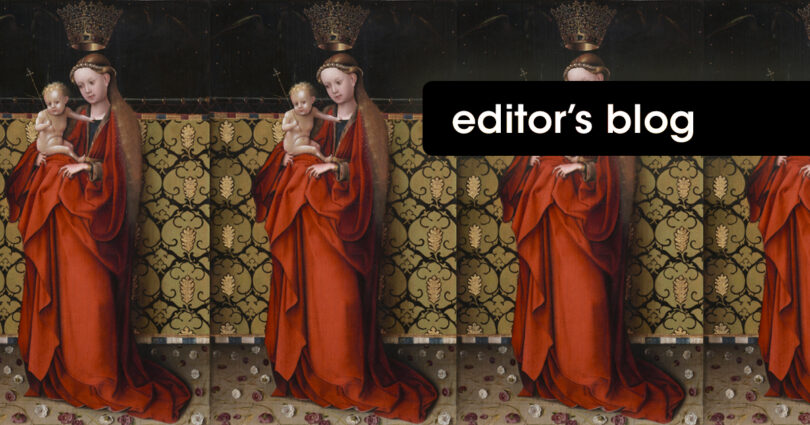On August 22, we celebrate the Feast of the Queenship of the Blessed Virgin Mary. Established by Pope Pius XII in 1954, this feast illustrates the fact that not only is Mary queen of heaven and earth, but that in this role, she is also our spiritual mother.
Franciscan Media explains that Mary’s queenship has biblical roots, with one of the most outstanding being during the Annunciation, when “Gabriel announced that Mary’s Son would receive the throne of David and rule forever.”
In addition to its biblical roots, Mary’s queenship is found in Church Tradition as well. As Pope Paul VI wrote in 1964 in Lumen Gentium, “The Immaculate Virgin, preserved free from all guilt of original sin, on the completion of her earthly sojourn, was taken up body and soul into heavenly glory, and exalted by the Lord as Queen of the universe.”
And in Ad Caeli Reginam (On Proclaiming the Queenship of Mary), Pope Pius XII wrote, “The Blessed Virgin Mary should be called Queen, not only because of her Divine Motherhood, but also because God has willed her to have an exceptional role in the work of our eternal salvation.” He continued, “Iconography, in representing the royal dignity of the Blessed Virgin Mary, has ever been enriched with works of highest artistic value and greatest beauty.”
I believe that nowhere is Mary’s queenship depicted with more beauty than in “The Virgin Crowned by Angels,” painted by German artist Stefan Lochner—a distant relative of mine—in the mid 1400s.
Housed at the Cleveland Museum of Art, this exquisite painting depicts Mary holding Baby Jesus and lovingly gazing at him. Above Mary, so faint that you can barely see them, are two angels crowning her as queen.
One has to wonder why Lochner chose to depict Mary holding Baby Jesus when other famous painters have traditionally painted just Mary flanked by angels or even Mary sitting upon a throne. Not much is known about Lochner, but one can only suppose that he believed that Mary and Christ were the central figures and that to depict the angels in great detail may have detracted from the focus, which is the Christ Child.
While we see a resplendent crown above Mary, we can’t help but notice that the most poignant thing in the painting is Mary’s expression as she looks upon the baby in her arms. Though her look is filled with love, it also has a hint of pensiveness or maybe even a slight sadness, as she knew that her Son would eventually give His life in reparation for our sins.
Any mother who knows of such a fate could not help but feel a sadness mixed with that deep love for a child.
And so, Mary and her baby are the focus of this painting, as Lochner probably rightly understood that Mary could never have attained that queenship if not for her Son’s kingship. I think, to Lochner, Mary’s queenship points us toward Jesus. It’s all about her Son. Therefore, we can say that it’s all about motherhood.
As Catholics, we know that, while Mary was Jesus’ earthly mother, she is now our spiritual mother, for as Jesus hung on the cross, He gave her to us all. Now Mary also holds us in her arms, just as she holds Baby Jesus in her arms in Lochner’s painting. And just as she gazes upon Him with love and possibly a bit of sadness, so she gazes upon us with the same deep maternal affection.
This is the epitome of motherhood—a love so strong and so complete that our children’s pains are our pains, their joys our joys, their sufferings our sufferings. Mary knew all of this, so there is no more perfect model for mothers than she, and we need only look to her when we struggle with the trials or the fears of motherhood. In fact, Mother Teresa once said, “If you ever feel distressed during your day, call upon our Lady, just say this simple prayer: ‘Mary, Mother of Jesus, please be a mother to me now.’”
We can learn so much about motherhood from Mary. Her unconditional love is a love we must impart not only to our own children, but to all children—born and preborn—for to do anything less would be to reject the gift of motherhood and children that God has given us.
So as we think about this special feast day, let us look at the world around us and about how the world depicts motherhood, throws it away, and sometimes holds it in disdain. Let us go to our mother in prayer, asking for others to see babies through her eyes.
Mary’s loving gaze in Lochner’s painting is the gaze of motherhood that our country seems to have lost. But it’s not one that must be lost forever. Through prayer, through education, and through love, we can restore a reverence for the gift of motherhood.
Just as Mary’s gaze is on Jesus, that is where our gaze must be as well. Her eyes point us toward Him. Let us allow her to lead us.
This article first appeared in the Catholic World Report at catholicworldreport.com/2024/08/22/marys-queenship-directs-us-toward-her-son-and-to-motherhood.


Facebook Comments